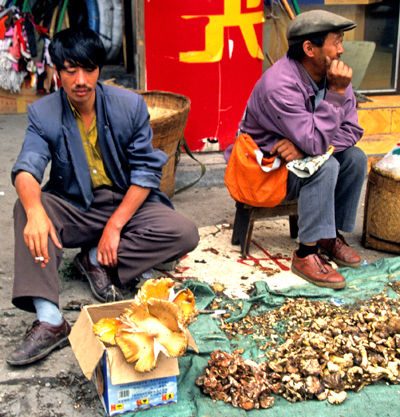| Other Economic Mushrooms of the Tibetan Plateau |
Cantharellus - Chanterlles Agaricus campestries - Meadow Mushroom |
||
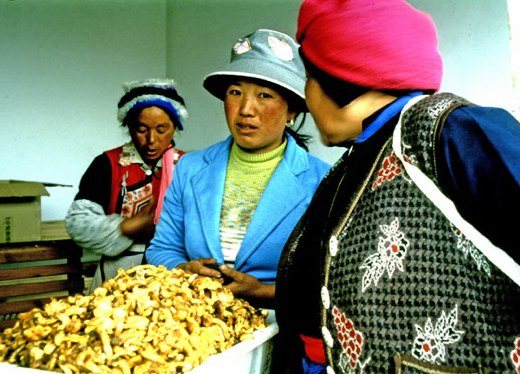 |
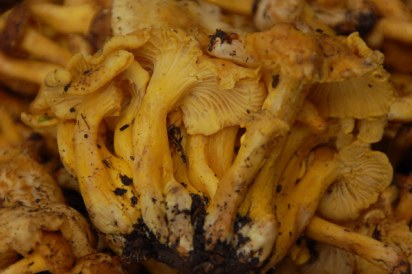 Cantharellus minor? for sale at the mushroom market in Dartsedo / Kangding, Ganzi TAP, Aug. 6, 2007 © Daniel Winkler
|
||
|
Gyalthang ladies with a load of Chanterelles ready to be sold to a wholesaler at the mushroom market in Gyalthang (= Zhongdian). The chanterelles traded are mostly Cantharellus cibarius with a few Cantharellus minor mixed in. In Chinese the chanterelle is known as Jiyou Jun, which means chicken fat mushroom. Zhongdian / now Shangrila / Sangerila County, Dechen / Deqing TAP, Yunnan, July 2000 © Daniel Winkler
|
|||
 An orange birch bolete, probably Leccinum versipelle, at the mushroom market in Dartsendo / Kangding, Ganzi TAP, Aug. 6, 2007 © Daniel Winkler
|
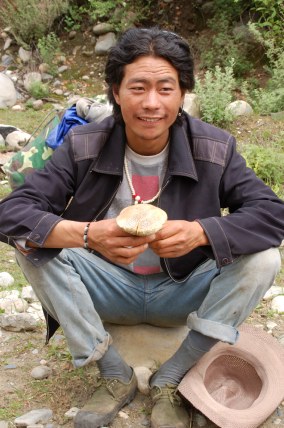 A Kongpo man holding a Leccinum (scaly bolete, Chinese: Niugan Jun). He just came down from the alpine grasslands, but had no luck in finding caterpillar fungus and picked thisLeccinum for dinner instead. Photo: Sero / Saiwo, 3400m, Kongpo Gyamda / Gongbo Jiangda County, Nyingchi / Linzhi Prefecture, Tibet AR, June 2006 © Daniel Winkler
|
||
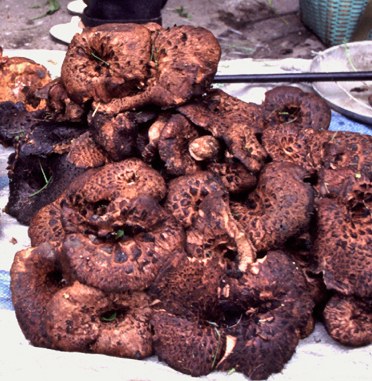 Sarcodon imbricatus (=Hydnum imbricatum), the Hawk's Wing is a popular and commonly eaten mushroom in Tibet. It is a widely distributed root-associated coniferous forest fungi collected all over the area. There are also other, similar, big brown Sarcodon / Hydnum species in trade. Its Tibetan name is "Sha drö" . "Sha" means meat or mushroom, "drö" means stomach. The Chinese name is Zhangzi Jun, the deer mushroom)
Photo: August 1998, Derge (Dege) County, Ganzi / Kandze TAP, W-Sichuan.© Daniel Winkler
A wood-fired mushroom dryer in Maigundo, Lithang. The local mushroom harvest is taken to this village to dry mushrooms before selling them off to urban markets in the Tibetan areas or exporting them down to China.
Photo: July 30, 2007, Dala District, Lithang County, Ganzi / Kandze TAP, W-Sichuan.© Daniel Winkler
|
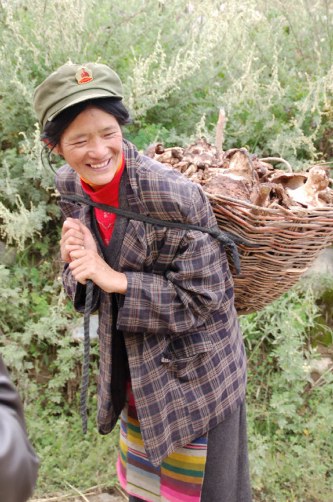 Khampa lady in Lithang carrying a load of Shadrö to the wood fired dryer in the next village. Photo: July 30, 2007, Dala District, Lithang County, Ganzi / Kandze TAP, W-Sichuan.© Daniel Winkler
 A pulled drawer reveals that its bottom is made from spaced slats so that hot air can circulate and dry out the mushrooms.
This kind of dryer is quite an advancement from traditional drying over the fire or hanging the mushrooms somewhere in the house. The old style provided intended or not always a strong smoked flavor, often overpowering the fungal taste.
|
||
|
Amanita hemibapha var. ochracea, a close relative of Amanita caesarea, Caesar's mushroom (in box ), for sale by Sichuanese in Kangding. Photo: August 2001, Kangding / Dartsedo, Ganzi / Kandze TAP, W-Sichuan.© Daniel Winkler
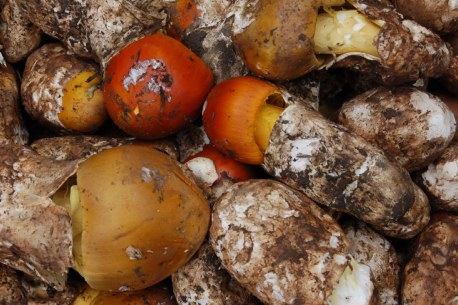 Young Amanita hemibapha and Amanita hemibapha var. ochera (the dull brown ones) at the mushroom market in Dartsedo / Kangding, Ganzi TAP, Aug. 6, 2007,
© Daniel Winkler Agaricus campestris - Kar Shamo
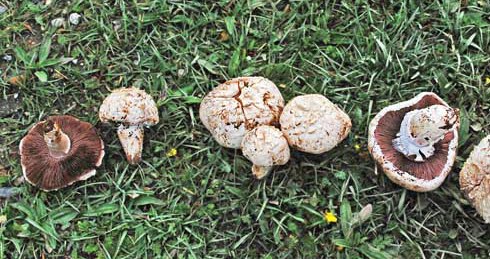 Agaricus campestris or closely related button mushroom species are known in Tibet as Kar Sha, the White mushroom, on the Changtang also known as Phuk-sha (spelling maybe phugs-sha) is the most widely known and eaten mushroom on the Tibetan Plateau. Rongpatsa, Ganzi County, Ganzi TAP, June 1, 2019, © Daniel Winkler
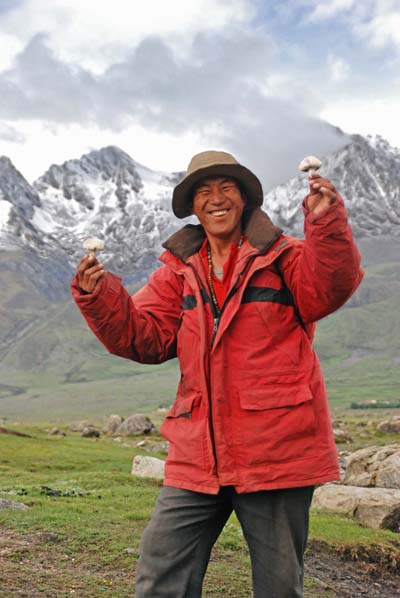 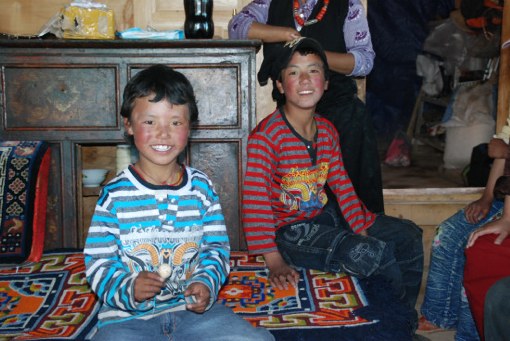 |
 Amanita hemibapha and its ochre variety Amanita hemibapha var. ochera are ecto-mycorrhizal fungi known in Tibetan as Shing-A, the chicken egg mushroom, basically the same name as in Italian where it is known as "ovulo buono", the good egg. Also its Chinese name Jidan Jun refers to the egg-like stage when the mushroom is still mostly covered by the whitish universal veil, but already shows part of its orange, egg yolk colored, unopened, egg-shaped cap. The other, reddish mushroom is Hygrophorus russula and to the right a Tricholoma, although looking similar to T. saponaceum, regarded as an edible in the area. Photo: August 2007, Kangding / Dartsedo, Ganzi / Kandze TAP, W-Sichuan.© Daniel Winkler
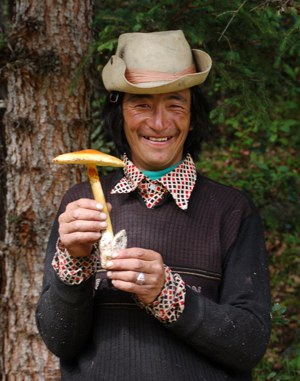 A nice Amanita hemibapha found by a Litangpa.
Lithang County / Litang Xian, Ganzi TAP, W-Sichuan, Aug 1, 2007, © Daniel Winkler
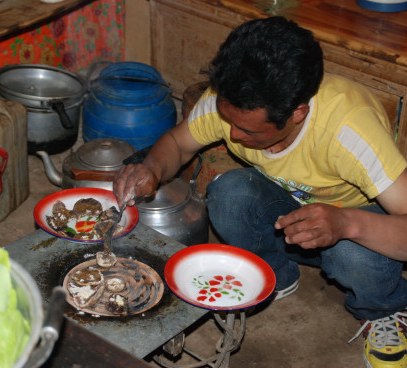 Karsha cooking the traditional way on an electric stove. First the caps are washed and then cooked gills up. The moisture protects them from burning while the mushroom cooks. Onto the gills some butter is added and some tsampa - roasted barley flower and a pinch of salt.
 Karsha ready to eat - Shimpu du!
|
||
|
last change 12-15-2011
|
|||
- MushRoaming
- MushRoaming Home
- Amazing Amazon
- Pacific Northwest
- Truffles in the PNW
- Cordyceps Tour 2010
- Cordyceps & Morel Tour 2008
- Tibet Fungal Floral Foray 2010
- Tibet's Mushrooms
- Mushroaming in the Alps
- Mushroom markets (Munich etc.)
- Fire Morels 2013
- Colorado Mushrooms
- Hawaii Mushrooms
- Bhutan's Mushrooms
- Pilzreisen (in German)
- MushRoaming Tours
- Cordyceps
- Presentations & Events
- Goods & Resources
- Photo Gallery
- Tibet Photo Essays
- Colombia 2023
- Bhutan 2019
- Colombia 2020
- Home page Gallery
- Suriname Tepu 2019
- Suriname 2018
- Colombia 2019
- Bhutan 2018
- Colombia 2017
- Colombia 2016
- Colombia 2015
- Colombia 2014
- Morel-Cordyceps-East-Tibet-2015
- Tibet Kham Summer 2012
- Bolivia 2014
- Bolivian Amazon 2013
- Bolivia Rain Forest 2012
- Mushroaming Kerala
- Alaska Mushrooming
- Contact us


